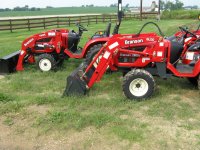Artisan
Veteran Member
I know little about hydraulics. The BX25 is a lil pit bull but the FEL
lift acts more like a poodle. I know I can bump up the pressure but would
it not be wiser to simply make larger cylinders that fit in that holes made
to OE dimensions?
The OD of the BX25 FEL Lift cylinders, (the bore?) is 1.85" and the
rod or the shaft OD is .985". If I use 1850 Lbs (max stock psi) for pressure that
gives me 4973 Lbs Push and 3563 Pull. If I keep the same shaft size
and go to a 2.5" Bore (I think the bore is the cyl OD) that changes
dramatically to 9081 Push and 7671 Pull.
"IF" a guy were responsible, and low and slow is always mandatory and
if a guy does not get silly using the very left or right side and full power
possibily tweaking the FEL does this sound viable?
lift acts more like a poodle. I know I can bump up the pressure but would
it not be wiser to simply make larger cylinders that fit in that holes made
to OE dimensions?
The OD of the BX25 FEL Lift cylinders, (the bore?) is 1.85" and the
rod or the shaft OD is .985". If I use 1850 Lbs (max stock psi) for pressure that
gives me 4973 Lbs Push and 3563 Pull. If I keep the same shaft size
and go to a 2.5" Bore (I think the bore is the cyl OD) that changes
dramatically to 9081 Push and 7671 Pull.
"IF" a guy were responsible, and low and slow is always mandatory and
if a guy does not get silly using the very left or right side and full power
possibily tweaking the FEL does this sound viable?
